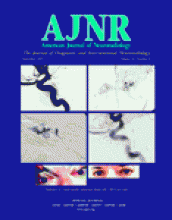Reply
Note:Due to an oversight, this reply did not appear with the following letter in the August issue.
Reply
We thank Drs Sluzewski and van Rooij for their criticisms of the ACTIVE Study, the results of which were published in the newsletter from Boston Scientific and referred to in an AJNR editorial (1). It is rare that new material is criticized to the point that the goal is described as more or less opposite to what was expected by the originators.
First, the criticism is perfectly right regarding the rebleed rate, which is 7% instead of 3%. The rebleed rate must be calculated among patients who presented with a ruptured aneurysm. There are several explanations for this high percentage: 1) Two patients in the ACTIVE Study presented with dissecting aneurysms and should not have been included because the treatment strategy was not adapted for such aneurysms. Thus, the rebleed rate should be 2%. This number in “absolute value” is still higher than what is reported in the literature. However, the number of patients is too small to be statistically significant. 2) Other parameters should be considered. At the time of the study, no other tools except Matrix coils were used to accomplish the treatment, which was a major limitation (this is not an excuse; it is a bias of the study and it was obviously a mistake). The large majority of patients also clearly presented with wide neck aneurysms. Additionally, the stiffness and friction of the first Matrix coils were limitations to obtaining good packing. The conjunction of these parameters might explain the lack of “completion” of the sac compared to results with bare coils (whose suppleness and shapes can be varied at latitude) and the “so-called” higher rebleed rate. However, this argument has no statistical authority.
The statement by Drs Sluzewski and van Rooij that “Apparently the Matrix coils allow residual filling of the aneurysmal sac over an unknown period of time and during this period the patient is not protected against a rebleeding” is a hypothesis, not an explanation. Their statement is based on a visual appreciation of the “packing density” after a Matrix coil treatment. However, Matrix coils carry a given percentage of radiolucent material (PGLA), and it is obvious that visual comparison with regular bare coils (regardless of the manufacturer) was not adapted. By definition, the so-called packing density will always be less with Matrix due to this percentage of transparent material.
With regard to the retreatment rate, the confusion exceeds that for the rebleed rate. Ninety-nine percent of recurrences are angiographic, not clinical. What does this mean for the patient? Worldwide, there is no agreed-upon definition of a recurrence of an aneurysm and no agreement on its incidence in patients on a long-term basis. Consequently, there is even less definition and less agreement on which recurrences should be retreated and why. This situation raises the very crucial question of why and when an angiographic recurrence should be considered for retreatment. For the time being, retreatment (with the exception of rebleeding, which is very rare) is a strictly personal decision, more or less empiric, which implies only the person who makes the decision. This comment is an important criticism, but it applies to endovascular treatment in general and cannot be used to oppose Matrix only. The ACTIVE Study was conducted 3 years ago with strict honesty. Meanwhile, and because of the information obtained from the study, the material and results have dramatically improved. We now have enough retrospective data to prove that a “Matrix effect” exists (forthcoming publications). This effect includes angiographic improvement of anatomic results on a long-term basis versus bare coils. But the real debate is based on the following: 1) Are bioactive coils, such as Matrix, bringing real clinical benefits for patients? In other words, is it necessary to use 20% to 30% more expensive materials to get a better angiographic appearance (the so-called Matrix effect) on control angiograms? The answer is yes if there is a significant benefit in terms of decreased rebleed rates during 10 or 15 years versus bare coils. If not, the answer is definitively no. Nobody knows the answer at present, but it is the duty of the medical community to find it. 2) Another very important part of this debate is to know whether we are happy enough with bare coils to the point where we decide that no further evolution is mandatory. At least we have a clear negative answer to this second stake. Matrix belongs to the future. It is a new concept that will change the results of aneurysm coiling. Even if the material (Matrix) itself disappears, the concept will persist and develop. For this reason, we have to thank the company. However, as doctors we also have to be very careful and not give way to the sirens of marketing arguments, which will never be scientific proofs. In light of the promising results during the last 3 years, we have no ethical problems in using Matrix coils. Think back to just 12 years ago, when everybody was happy with the results of microsurgical clipping of aneurysms. How many suspicious, negative, or destructive comments were made during the first 6 or 7 years of coiling aneurysms? Probably as many as the total number of aneurysms coiled from the beginning!
If we continue to behave ethically, the future of Matrix coils and other products from competitors will depend only on their intrinsic properties to benefit patients, which is fine. Nevertheless, the interventional neuroradiology community needs to reach a consensus on ways to prove superiority or inferiority of new materials independently of companies.
References
- Copyright © American Society of Neuroradiology












